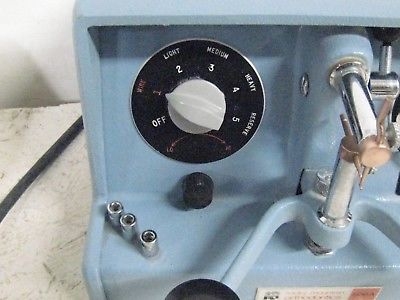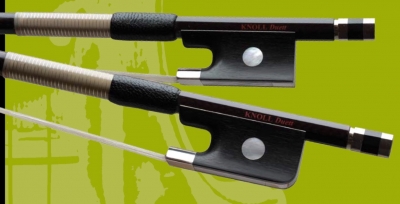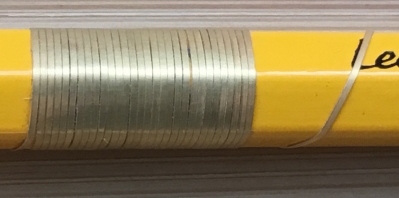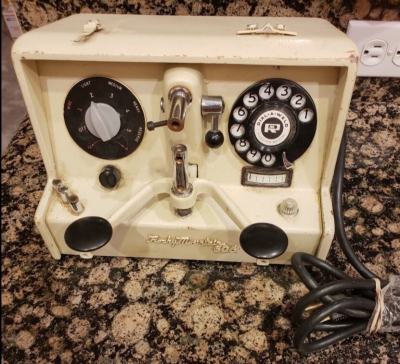Welcome to our forum. A Message To Our New and Prospective Members . Check out our Forum Rules. Lets keep this forum an enjoyable place to visit.
Currently working on errors from the latest (SimplePress) forum update. Many issues have been resoled and others are being worked on. Thank you for your patience.
 Topic RSS
Topic RSS



 (1 votes)
(1 votes) Regulars
 Offline
Offline

Success is the progressive realisation of a worthy ideal. —Earl Nightingale.
Honorary advisor
Regulars
 Offline
OfflineRegulars
 Offline
Offline

Regulars
 Offline
Offline

I went to the local jeweler for tips on how to solder the tungsten wrap on a bow stick. He said that any conventional means could be used on the gold plated material. He was intrigued with the pure tungsten wire. He said that the most cost effective method of repairing jewelry was to use a pulsed YAG laser. He farmed out that work to a visiting goldsmith, who is showing up this Thursday. I left my wrap sample to see if it could be done.
Naturally, I went on the internet to see what the equipment looked like. It is quite a machine, with an integrated microscope for alignment and ports for your hands. No idea how it controls laser reflections.
Success is the progressive realisation of a worthy ideal. —Earl Nightingale.
Regulars
 Offline
Offline
Irv said
I went to the local jeweler for tips on how to solder the tungsten wrap on a bow stick. He said that any conventional means could be used on the gold plated material. He was intrigued with the pure tungsten wire. He said that the most cost effective method of repairing jewelry was to use a pulsed YAG laser. He farmed out that work to a visiting goldsmith, who is showing up this Thursday. I left my wrap sample to see if it could be done.Naturally, I went on the internet to see what the equipment looked like. It is quite a machine, with an integrated microscope for alignment and ports for your hands. No idea how it controls laser reflections.
Wow! That's well beyond my skill level. I don't think I could handle that.
- Pete -
Regulars
 Offline
Offline

Well, pchoppin, if the service is inexpensive enough, I just do the wrap, using masking tape to secure the wire on either side. The laser will fuse the wire on each end of the wrap discretely on the hair side of the stick. The extended length of excess wire will be cut with a diamond disc powered by a Drexel grinder and smoothed.
Success is the progressive realisation of a worthy ideal. —Earl Nightingale.
Honorary advisor
Regulars
 Offline
OfflineRegulars
 Offline
Offline

Hi chicken. I just got a lead on a really small capacitor discharge welder. It looks like the electrodes are made out of copper (which are not included, so I can get it cheap). Sound right to you? I should be able to fab those with my lathe. It was used to weld titanium/nickel alloy wire of a slightly thicker gauge. If nothing else, I should be able to weld nickel ribbon on lithium batteries.
Success is the progressive realisation of a worthy ideal. —Earl Nightingale.
Honorary advisor
Regulars
 Offline
OfflineLike a spot welder? clip it or clamp it and melts together without any kind of filler? If so the tips are made of copper. If the company is still in business you should be able to buy them for little to nothing. If not, you can definitely mill them out yourself. I'll bet money you have a threader or a tap and die set laying around.
Honorary advisor
Regulars
 Offline
OfflineYou need to figure out a way to get the electrodes in direct contact, >l< with what your welding. Directly across from each other if possible. It's called direct resistance welding, or resistance spot welding. Allow for some expansion or retraction or both.
Or you could press at both ends and see what happens, hit it 2 or 3 times. It'll either weld itself or create a coil and burn up a pencil.
I think it'll work.
Regulars
 Offline
Offline

Hi Chicken and others. I have to be a little coy because the sale has not been made yet. I copied a picture of the parts I need (everything with a copper color). I think that I can make the electrodes from a electrician’s grounding rod. The electrode holders are turned cylinders with through bores. The electrodes are held in with a grub screw. No big deal. The welder uses an old style rotary telephone dial to vary the number of pulses discharged and a rotary knob to adjust voltage applied to the capacitor. It uses insulated paddles so that hand pressure brings the work to the electrodes. The whole unit looks to be the size of an old bread toaster. 
Success is the progressive realisation of a worthy ideal. —Earl Nightingale.
Honorary advisor
Regulars
 Offline
OfflineIrv said
Hi Chicken and others. I have to be a little coy because the sale has not been made yet. I copied a picture of the parts I need (everything with a copper color). I think that I can make the electrodes from a electrician’s grounding rod. The electrode holders are turned cylinders with through bores. The electrodes are held in with a grub screw. No big deal. The welder uses an old style rotary telephone dial to vary the number of pulses discharged and a rotary knob to adjust voltage applied to the capacitor. It uses insulated paddles so that hand pressure brings the work to the electrodes. The whole unit looks to be the size of an old bread toaster.
Irv I love that. Hard to find the good stuff anymore. Here's what I have learned about tools over the decades, the less they dress it up, the better it seems to be. Honestly, you got me wanting to do this too.
Regulars
 Offline
Offline

I have two rolls of the unplated tungsten, so let me know if you want to experiment. I also received the dyed kangaroo leather, which is gorgeous. It appears that the standard leather for violin bows is either water buffalo or lizard. I know kangaroo will take wear and abuse. I don’t know about perspiration.
I hope that the capacitor welder does the trick. It looks like the internals are completely analog, so I think that I can handle any repairs if required. Somehow, I think that the visiting goldsmith with the yag laser is going to be too expensive for my taste. I also have an AC Tig welder on site, but I see flaming sticks with that rig.
Success is the progressive realisation of a worthy ideal. —Earl Nightingale.
Regulars
 Offline
Offline

Honorary advisor
Regulars
 Offline
Offline@Irv Whoa, my dad had one of those years ago exactly like it. You can fish with it, fish come floating to the top of the water. He had a crank telephone we fished with too, had some bite to it. If you decide it's not what you want, it is Christmas.
If you go inside of it and monkey around, don't forget to discharge it. I have had the feeling of being hit by a Mac truck thanks to sweaty arms.
I knew about the lizard wraps, had no idea about water buffalo, but it makes sense. as for the wire, when you get to rolling, I want some already wrapped around one of your bows. A one of a kind, possibly an evolution in the bow industry. I can tell people I knew you when you weren't near as rich. lol
Regulars
 Offline
Offline

Hi Chicken. That is not fishing. That is catching. How did you handle the AC, fish from a dock? One would think that 1/4 sticks of dynamite was more your style.
I looked at a grounding rod. Copper plated steel rod. Hardware store suggested solid 0.16 inch diameter bare copper wire, $1/foot. Should work fine for my needs.
It appears that the metal cylinders on the left side of photo are holders for wire surrounds for various sized teeth, which secure into vertical column. It should chooch pretty good for my needs.
I hear you on the capacitor. I had a $5/week fund to purchase mechanical things at tag sales for the expressed purpose of taking them apart when I was a kid. Two things were off limits: tube televisions (fly back transformer) and old style phonograph (main spring).
Check out the combination of whale bone and silver wire on this bow wrap. I could do something similar with the gold plated tungsten ribbon.

Success is the progressive realisation of a worthy ideal. —Earl Nightingale.
Regulars
 Offline
Offline

Hi Chicken. Just got done reading a book on making a split bamboo rod with a twist in it. He gave plans that show how to coordinate the spiral with the guide locations. Evidently, the spiral gave the rod a pre-load that provided extra spring strength given the same amount of material. I think that I could incorporate that into my bow design.
Success is the progressive realisation of a worthy ideal. —Earl Nightingale.
Honorary advisor
Regulars
 Offline
OfflineHave to have a license to buy dynamite now days. It was hard enough before 9-11 near impossible after. Thermite is still accessible if that makes any sense at all.
Dad was a musician all his life but became a master mechanic maintenance man welder for goodyear tire and rubber. He knew things man, strange things. He would sometimes ground into the ground and lead into the water, sometimes both in the water, and we would row around in an aluminum boat scooping up the fish. I had a wonderfully dangerous childhood. Very common practice to use an extension chord and a tire iron to get worms out of the ground. Had a wooden alligator trap that would electrocute alligators up to 16 feet long. As long as your not grounded, you're all good.
I like the look of the knoll bow. Pretty sharp. I think a bamboo bow would look sharp in its natural wood form with a goldish wrap. People love to be different and express their individuality. You might be onto a gold mine.
Regulars
 Offline
Offline

Hello Chicken. Strangest use of a DC welder I know of was in the First World War. Allied trenches were damp with mud and water on the floor. German trenches were bone dry. Water is a polar substance. The Germans used a DC current to move the water away from their trenches.
Just about all Russian buildings use concrete piers with an iron point. When the piers are set, the point is electrified (I think I remember positive), which attracts ground water and makes sinking the pier easier. They got the technology from the Germans.
EDIT: I remembered the modern name given to this technology. It is called electrophoresis.
Success is the progressive realisation of a worthy ideal. —Earl Nightingale.
1 Guest(s)


 Log In
Log In Register
Register



























